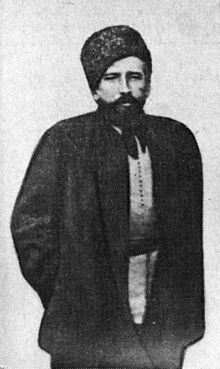Karus Kahanez
| Karus Kahanez | |
|---|---|
| Surname | Kazimir-Rafail Karlawitsch Kastrawitsky |
| Original name | Казімір Карлавіч Кастравіцкі |
| pseudonym | Карусь Каганец, К.К. Будзімір, К. Шашаль |
| birthday | February 10, 1868 |
| place of birth | Tobolsk , Russia |
| Date of death | May 20, 1918 |
| Died in | Primogilje, Djarshynsk Raion (Minskaya Woblasz) , Belarus |
| activities | Poet, dramaturge, artist |
| Creative years | 1893-1918 |
| Language of works | Belarusian |
| Cyrillic ( Belarusian ) | |
|---|---|
| Казімір Карлавіч Кастравіцкі | |
| Transl. : | Kazimir Karlavič Kastravicki |
| Transcr. : | Kasimir Karlawitsch Kastrawitsky |
| Cyrillic ( Russian ) | |
| Казимир Карлович Костровицкий | |
| Transl .: | Kazimir Karlowič Kostorwickij |
| Transcr .: | Kazimir Karlovich Kostrovitsky |
Kasimir-Rafail Karlawitsch Kastrawitski , better known as Karus Kahanez (actually Kazimir Kastravicki ; born February 10, 1868 in Tobolsk ; † May 20, 1918 in Primogilje, Dzjarshynsk Raion (Minskaya Woblasz) ) was a Belarusian poet, novelist, playwright, children's author, Author of the first Belarusian textbooks, translator, linguist, folklorist, painter and sculptor. Karus Kahanez was a co-author of Naša Niva and achieved a high level of awareness in Belarus at the beginning of the 20th century. He was a relative of the French poet Guillaume Apollinaire .
Life
childhood
The parents of Kasimir-Rafail Kastrawitski, Karl Samuilovich Kastrawitski and Elena Tadeuschewna Kastrawitska came from wealthy aristocratic families. Mother Elena received her education in Vilnius and at the age of nineteen married Karl Kastrawitski, who was 21 years her senior. This and many close relatives took an active part in the January uprising of Kastus Kalinowskij (1863-1864) and were exiled to Siberia after the suppression of the uprising with their families. Kastrawitsky came to Tobolsk , where in 1868 their son Kazimir was born. He spent the first six years of his life in exile in Tobolsk until the family was allowed to return to Belarus in 1874. The family settled in the village of Zasulje, where Kasimir's father died at the age of 60, leaving his wife with four children without a living. At the age of 6, Kasimir was already working as a shepherd and spending a lot of time outdoors, which later inspired him to describe the beauty of the Belarusian landscape. The family lived in poor conditions and Kasimir's mother married a second time. After moving to Prymagille, where the mother got back the land that had not been confiscated, the family lived well again, even having servants and a bakery.
Casimir, apparently not loved by his stepfather and disregarded by his mother, left the house, continued to work as a shepherd in a neighboring county, and befriended peasant children.
Karus first got his education in a city school in Minsk, later he studied at the Moscow Academy of Painting, Sculpture and Architecture . In 1893 he began his literary activity and published his own works in various magazines.
Literary and social activity
From 1890 to 1900 Karus Kahanez published his adaptations of folk tales in the newspapers Minskij Listok and Severo-Zapadnyj Kraj . In 1902 he founded together with Anton and Iwan Luzkevich, Aleksandr Burbis, Eloisa Pashkewitch and others the Belarusian Revolutionary Party, which in 1903 changed its name to " Belarusian Socialist Hramada " (Biełaruskaja sacyjalistyčnaja hramada). In 1904 Kahanez founded the newspaper Polesje . In 1905 he took part in the first farmers' conference in Belarus.
arrest
Already in 1905 after the organization of a rally, Kahanez was arrested and had to serve the first prison sentence in Minsk until May 1906. In the same year the first legal Belarusian publishing house was founded. The sun will also look into our window , around which the Belarusian intelligentsia gathered. The publishing house started printing Belarusian textbooks and the first book to be published was the Belarusian Reading Primer by Karus Kahanez.
Works
Processing of folk tales
- Скрыпач і ваўкі
- Журавель і чапля
- Што кажух, то не вата
Essays
- Вандроўка кроплі вады
- Год
- Нашыя птушкі
stories
- Бывалы Юр у Мінску
- З нашага жыцця
- Тры алешыны
- На сплаве
Comedies
- Модный щляхцюк (1910)
- Двойчы прапiлi
Dramas
- У iншым шчасцi няшчасце схавана
- Страхажовы курган
- Сын Данiла
Textbooks
- Беларускі лемантар, або Першая навука чытання , 1906.
proof
- ↑ pawet.net
- ↑ Карусь Каганец - Биография ( Memento from July 14, 2014 in the Internet Archive ) (bukvaved.com)
- ↑ Severo-Zapadnyj Kraj
- ↑ dzerlib.by
- ↑ Тэатральная Беларусь, энцыклапедыя 1, Мінск, Беларуская энцыклапедыя 2002.
| personal data | |
|---|---|
| SURNAME | Kahanez, Karus |
| ALTERNATIVE NAMES | Kastrawitsky, Kasimir-Rafail Karlawitsch; Kastravicki, Kazimir (real name) |
| BRIEF DESCRIPTION | Belarusian writer, translator, linguist, folklorist, painter and sculptor |
| DATE OF BIRTH | February 10, 1868 |
| PLACE OF BIRTH | Tobolsk |
| DATE OF DEATH | May 20, 1918 |
| Place of death | Primogilje, Djarshynsk Raion (Minskaya Woblasz) |

